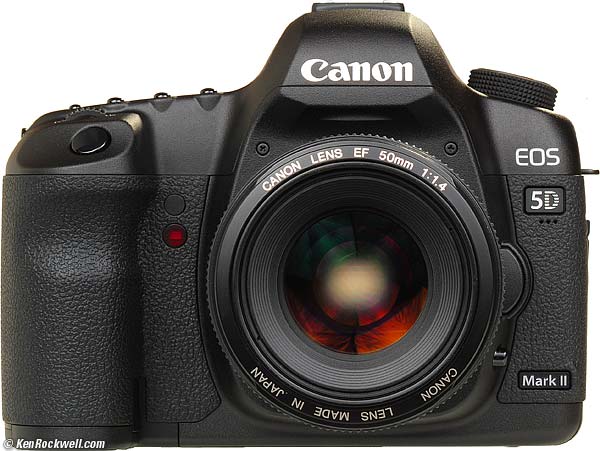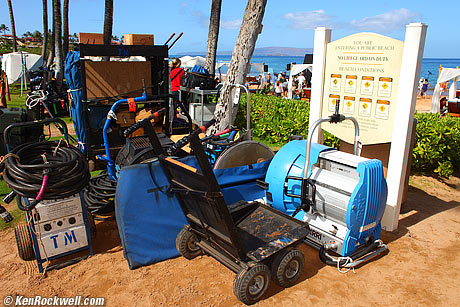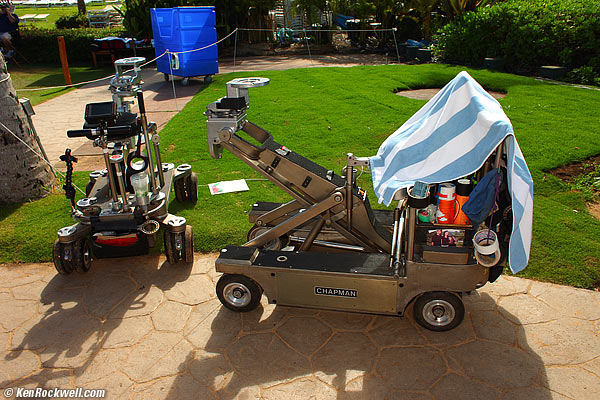Home Donate New Search Gallery How-To Books Links Workshops About Contact
Canon
5D Mark II Video
Why I Don't Care
© 2010 KenRockwell.com. All rights reserved.
5D Mk II Review Specs Performance Compared Usage Recommendations
Diagrams What's New What's Old Sales Fluff Lenses Video
Canon EOS 5D Mark II and 50mm f/1.4. enlarge.
May 2010 Canon 5D Mark II Review More Canon Reviews
|
Adorama pays top dollar for your used gear. I use these stores. I can't vouch for ads below. |
Introduction
The problem with DSLR video is that it's really only useful for large-budget productions, where a DSLR is merely sitting-in for a real $250,000 35mm motion-picture camera.
If Hollywood uses the 5D Mark II to shoot major motion pictures, then why isn't it good enough for me, especially if I'm already carrying it?
Simple: DSLRs have no real autofocus! They all claim some sort, but it doesn't really work, at least not if the subject is moving, which is the whole point of movies.
Worse, manual DSLR focus won't work in real-time because the finder goes black while shooting video. You can't see much looking at a 3" LCD as things move around.
For use by a single photographer, you can't get DSLRs to focus on things that move. If you can't shoot things that move, then why are you trying to shoot video? Video and movies need to track focus on things that move; that's the whole point.
When I want video of my family, even if I'm also carrying my Canon 5D Mark II, I still carry a real camcorder!
For Hollywood top
One very big little thing that all the hoo-haa about DSLR video conveniently forgets to tell everyone is that when Hollywood shoots anything, they have a crew of 45 guys running around the week before rigging lighting, scrims, gobos and generators, building dolly tracks and grip, and a zillion other things.
Big ARRI lights on location in Maui. bigger.
There are at least three guys assigned to operate the camera, and that's just to operate it. The Director of Photography (DP) and the Director are the ones who figure out where it goes and where it's pointed.
Among these camera operators is the focus puller. Hollywood shoots everything in manual focus, and the focus puller very manually "pulls" focus in and out during each shot as actors move around.
Focus is rehearsed like everything else. As the stand-in actors move among their marks (masking tape on the floor that lets them stand in exactly the same positions for each take), the focus puller makes a mark on his big white focus ring. Once everything is rehearsed, the focus puller can twiddle the ring back and forth to each distance as the actors run through their marks during each shot, so everything is in perfect focus as people move around, or as your eye moves from actor-to-actor in a two-shot of them talking. (similar as made by Panavision.)
When shooting a DSLR for motion-picture use, the DSLR is attached to the same complex grip equipment that has this focus mechanism attached to whatever lens is used. Lenses are made by Zeiss, Panavision and Cooke. Popular cine lenses are not made by Canon, not by Nikon and not by Fuji; those are TV, not cine lenses. Cine lenses have gears on their control rings so that they cam be rigged-up to the complex attachments that allow precise external control of focus, zoom and aperture.
If you're doing the sort of Hollywood shoot where you have 45 people on a call sheet like transportation captains and drivers, makeup artists, hair stylists, craft services, unit managers, construction group heads, carpenters, set dressers, propmasters, welding foremen, gang bosses, rigging electricians, generator operators, marine riggers, gaffers, crane operators, filtration technicians, etiquette coaches, lamp operators, lamp technicians, 24-frame video playback people, security, and of course, pyro technicians, then you might have a focus puller, and you might want to consider a DSLR in place of your Panavision or ARRI to save on film costs.
If you're merely shooting video with only several assistants, like a TV station or a wedding videographer or shooting live events where you can't rehearse focus in advance, you can't get focus to track anything moving, thus DSLRs don't do anything for you.
The reason to shoot movies is to portray motion. An image needs to be in focus, thus you need to track focus for moving subjects.
If something holds still, you don't need a moving image. If something moves, you need a focus puller and a special rig with special Hollywood focusing hardware to shoot with a DSLR.
DSLR video is for serious professional production, which is why you'll see it promoted as being used on big productions.
For Me top
For me, photographing unrehearsed family events, my old camcorder tracks motion, and has a smooth motorized zoom lens that covers every angle. My camcorder records in stereo, while DSLRs only have mono microphones. My camcorder records at 25mb/s for over an hour at a time on a tiny DV tape, while a DSLR gives up after 10 or 20 minutes, if it doesn't melt first.
I prefer the video I get from any pocket camera, like my Canon S90, which uses a design similar to a camcorder, so it can autofocus while shooting video.
Why DSLRs Can't Autofocus Well top
DSLRs are not yet optimized for focus for video shooting as are camcorders and pocket cameras. DSLRs focus through the lens optically in real-time and 3-D, but they can't do that when the mirror flips-up and the AF sensors no longer can see. Instead, DSLRs have to revert to slow, reactive focus based on the flat images that are coming off the image sensors. The problem with image-sensor based AF is that:
1.) The images have to be read from the sensor before they can be analyzed. The subjects have moved-on before the camera can even start to analyze an image!
2.) Images taken from image sensors are only 2-dimensional. To work, image-sensor-based AF has to look at many images that come off the sensor in sequence to figure out in which direction to move the focus. By comparison, for still images with the mirror down, the optical AF sensors that look through the lens directly see in three-dimensions in real-time. Optical AF sensors already know in what direction, and how fast, to move the lens, while your DSLR video is still waiting to pull flat images off the sensor.
3.) Camcorders and point-and-shoots are optimized for AF because their internal architectures are designed to read images from the image-sensor at much higher frame rates while trying to focus. DSLRs can't do that because they aren't designed that way; their higher resolutions usually get in the way.
Sensor Dirt top
When you shoot video on a DSLR, the sensor is uncovered the whole time. When you shoot stills, the sensor is sealed behind the shutter except for during the one short exposure.
When producing motion pictures, the camera only rolls a small percentage of the time. Most of the time people stand around eating donuts while things are moved around the set.
Run TIme top
DSLRs get very hot and unhappy if you run them too long at any one time. The Canon 5D Mark II's manual clearly states (Page 13, USA v2 manual January 2010), that the 5D Mark II will get hot, and that it's perfectly normal for the 5D Mark II to cause "slight skin burns."
This isn't a problem in Hollywood where it gets plenty of time to cool as different scenes are set up (and the camera sits on a huge Chapman dolly), but it's Hell if you're trying to shoot hand-held.
Chapman dollies (camera supports). bigger.
Shallow Focus top
If the main reason to use a DSLR is to get shallow depth-of-field compared to a camcorder, what's the point if you can't get and keep it in perfect focus?
Summary top
Honestly, some serious videographers do buy rigs from places like Zacuto and are able to focus and see the LCD through loupes for manual focus, but it's still not something for people like me wanting to capture their kids.
These are just is a few reasons why I don't care about DSLR video. If I was a full-time DP, I'd be very interested, but as a still shooter, DSLR video doesn't concern me.
Help me help you top
I support my growing family through this website, as crazy as it might seem.
If you find this as helpful as a book you might have had to buy or a workshop you may have had to take, feel free to help me continue helping everyone.
If you've gotten your gear through one of my links or helped otherwise, you're family. It's great people like you who allow me to keep adding to this site full-time. Thanks!
If you haven't helped yet, please do, and consider helping me with a gift of $5.00.
The biggest help is to use these links to Adorama, Amazon, B&H and eBay when you get your goodies. It costs you nothing and is a huge help to me. eBay is always a gamble, but all the other places have the best prices and service, which is why I've used them since before this website existed. I recommend them all personally.
Thanks for reading!
Ken
Home Donate New Search Gallery How-To Books Links Workshops About Contact





